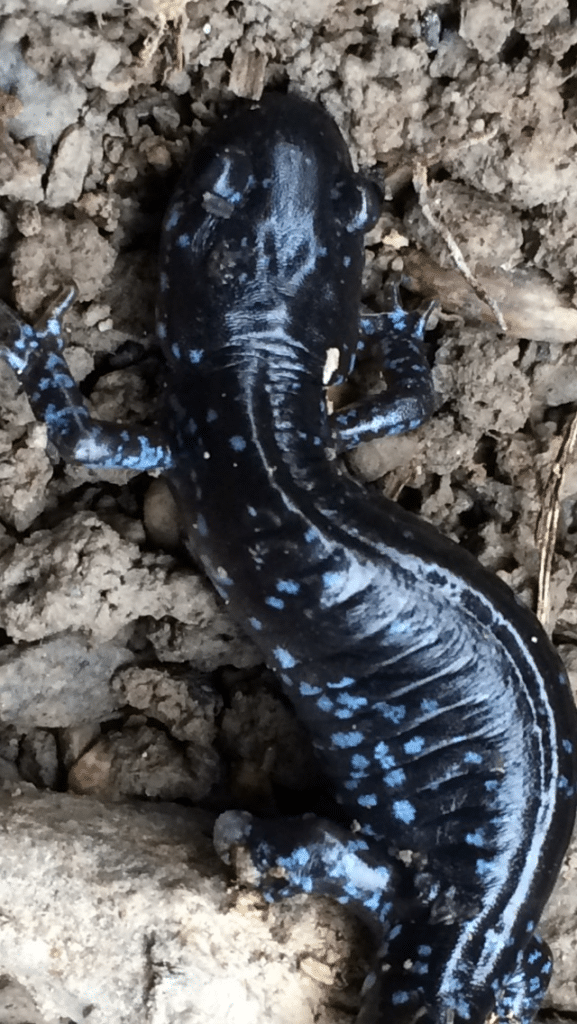
Did you know there are salamander species at risk in Ontario? While many people have probably come across the common Blue-spotted or Redback Salamanders when out in the woods of the FAB region here in Ontario, did you know there are 8 other Salamander species that are Endangered or Extirpated and very hard to find in Ontario?
If you have never had a chance to see a Salamander up close, their shape might make you think you are looking at a tiny lizard, with their skin being similar to that of a frog. However, unlike slippery, smooth frogs, salamanders have smooth, sticky skin, the kind you might want if you had to climb lots of vertical surfaces.
Most Salamander species at risk in the FAB region grow to be about 15 – 20 cm in length. They are usually shades of dark brown, grey, or black. Some species have beautiful blue spots decorating them. They really do have an ancient prehistoric appearance and seem unlike any other creature in the forest.
Salamanders are very old creatures, their existence dating back about 160 millions years ago. It’s incredible to think that such a tiny, softy, sticky creature has been able to survive everything the world has thrown at them for so long!
As these tiny beings don’t make much sound and they don’t always move very fast, it can be hard to spot them, especially if they are hiding under the leaf litter or a rotting log of the forest floor.

Salamanders are all about eating local! Considered ‘opportunistic feeders’ they tend to feed on what is available and in season, something we should all be doing. For them, the worms, insects, spiders and snails of the forest are the perfect meal. They may also eat small fish, tadpoles and even other salamanders! Their hunger for insects helps keep local ecosystems balanced and in check.
As much as they like to feast and dine on the local foods of the forest, there are of course animals that like to dine on salamanders. Birds, large fish, snakes, and mammals like skunks, racoons, and even foxes will prey on salamanders. However, their biggest threat is loss of habitat, and road fatalities when they are traveling to breeding grounds.
While there are two species of Salamander (Blue-spotted or Redback Salamanders) that are doing well in Ontario, there are quite a few that are in dire straights such as the:
- Allegheny mountain dusky salamander, Desmognathus ochrophaeus
- Jefferson salamander, Ambystoma jeffersonianum
- Northern dusky salamander, Desmognathus fuscus
- Small-mouthed salamander, Ambystoma texanum
- Unisexual Ambystoma (Jefferson Salamander dependent population), Ambystoma laterale-(2) jeffersonianum
- Unisexual Ambystoma (Small-mouthed Salamander dependent population), Ambystoma laterale – texanum
All 6 of those Salamander species are on the Endangered list in Ontario, and are at risk of imminent Extinction or Extirpation. Those species have very small populations, and very small habitat ranges. In some cases, these at risk populations have only 4 to 6 breeding ponds left. Habitat loss is the most significant threat to these special creatures.
There is also the Eastern Tiger Salamander and the Spring Salamander that is Extirpated in Ontario. “Extirpated” means this salamander once lived in the wild in Ontario, but no longer does. It can, however, be found living in other places in the world.
Without genetic testing, it can be very hard to tell one species apart from another. But, regardless of what type of Salamander you come across it’s important we do all we can to protect them.
How can you help protect Salamanders?
Due to their Endangered Species at Risk Status, it’s important that one be cautious and respectful when you encounter them in nature. Especially if you are camping or hiking.
The Ontario Ministry of the Environment, Conservation, and Parks gives us the following guidelines to help this important turtle species:
Report a sighting
The Ministry of Natural Resources and Forestry tracks species at risk such as the Unisexual Ambystoma (Small-mouthed Salamander dependent population). You can use a handy online form to report a sighting to the Natural Heritage Information Centre. Photographs with specific locations or mapping coordinates are always helpful.
Learn more about reporting wildlife.
Volunteer
Volunteer with your local nature club or provincial park to participate in surveys or stewardship work focused on species at risk.
Be a good steward
- Private land owners have a very important role to play in species recovery. If you find a Unisexual Ambystoma (Small-mouthed Salamander dependent population) on your land, you may be eligible for stewardship programs that support the protection and recovery of species at risk and their habitats.
- For farmers that have wetlands or ponds on their property, it’s important to fence these areas off from livestock. There are grants available to help with these costs.
- Visit the Ontario Reptile and Amphibian Atlas, the Canadian Herpetological Society websiteor Toronto Zoo Adopt-a-Pond website to learn more about amphibians in Ontario.
- Watch for salamanders that may be crossing roads, particularly between late March and April when they are migrating to breeding ponds. Road mortality is a serious threat to salamanders because they are slow-moving and hard to see on the road.
Report illegal activity
Report any illegal activity related to plants and wildlife to 1-866-MOETIPS (6638477)
Quick stats:
Status: Species at Risk, Endangered or Extirpated.
Description: Most Salamanders in Ontario range from 7cm to 20cm in length. They are all shaped similarly, and their colourations are similar ranging from black, dark grey, and brown.
Final adult coloration does not take place until Salamanders leave their breeding ponds.
Habitat: Salamanders always live close to ponds, small streams, seeps (areas where water in the ground oozes to the surface to form a pool) and springs, where they live under rocks, logs or leaf litter within or near water.
Location: Endangered Salamanders in Ontario are found in very specific areas such as Pelee Island, and the Niagara Peninsula.
While salamanders are a minor food source for a number of bird species in the FAB region, the nocturnal Whip-poor-will does not make meals of salamanders. Whip-poor-wills are also on the Species at Risk list and considered Threatened.
Check out our blog post about it to learn more about why they are important to our ecosystem. Whip-poor-wills





